Red light therapy can boost your eye health by stimulating mitochondria – the power plants of your cells – to produce more energy in your retinal tissue. You'll benefit most from morning treatments that use deep red wavelengths (620-700 nm), which help reduce eye strain and may slow age-related vision decline. Unlike harmful blue light from screens and LEDs, red light therapy enhances cellular function, reduces inflammation, and supports natural healing processes in your eyes. While blue light can damage your retina, red light therapy offers a gentle, sustainable approach to vision care. Understanding the right wavelengths and timing can maximize your treatment results.
Understanding Light Effects on Vision
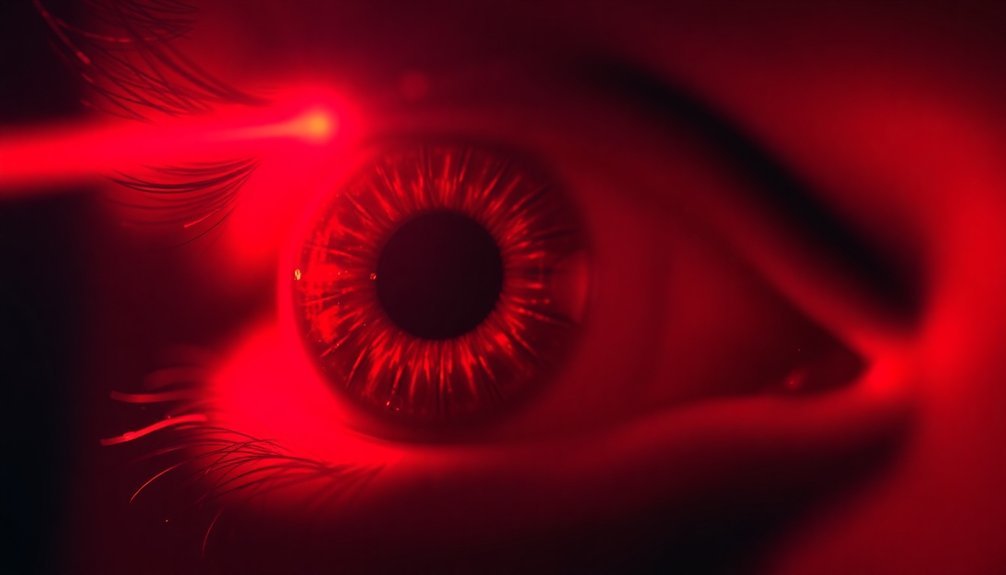
Light exposure's complex relationship with our eyes goes far beyond simple vision. Your eyes rely on sophisticated mechanisms to manage incoming light and protect your retinal health. When you're exposed to bright light, your iris automatically constricts your pupil to prevent excessive light from entering and damaging your retina. This natural defense system helps maintain proper visual processing and protects your eye's delicate structures.
You'll want to be cautious about direct light exposure, as staring at intense light sources like the sun can cause permanent retinal damage. Taking regular breaks using the 20-20-20 rule can help reduce eye strain when working with bright screens.
Your eyes are particularly vulnerable to UV rays and blue light, which can harm various parts of your eye, including the macula, cornea, and lens. Over time, chronic exposure to these harmful light sources can lead to serious conditions like macular degeneration and cataracts.
If you're spending significant time in front of digital screens, you're exposing your eyes to blue light that can cause digital eyestrain and focusing difficulties. This exposure becomes especially problematic at night, as it can disrupt your circadian rhythm and affect your sleep patterns.
Understanding these effects helps you make informed decisions about protecting your vision.
Red Light Versus Blue Light
When choosing between red and blue light therapy for your eyes, safety differences are critical – red light therapy offers proven benefits with minimal risks, while blue light can potentially harm your vision.
The wavelengths of red light penetrate deeper into ocular tissue to promote healing and reduce inflammation, whereas blue light's shorter, higher-energy wavelengths may cause photochemical damage over time. Red light wavelengths stimulate mitochondria production to enhance cellular function and energy levels.
You'll need longer treatment sessions with red light therapy to see results, but the recovery process is gentler and more sustainable compared to blue light's harsh effects on eye tissue.
Safety Differences Matter Most
Safety considerations overwhelmingly favor red light therapy over blue light therapy for eye treatments. While red light therapy has been shown to enhance color vision, contrast sensitivity, and retinal health when used properly, blue light therapy carries more significant risks for your eyes.
You'll want to be particularly cautious with blue light exposure, as it can cause eye strain and potentially contribute to long-term eye health issues. Simple goggles or protective eyewear should always be worn during treatment sessions.
You can safely use red light therapy at various times throughout the day, but you should restrict blue light therapy to morning and afternoon hours to prevent sleep disruptions. If you're seeking blue light exposure, it's safer to get it from natural sunlight rather than artificial sources.
When using either therapy, you must follow specific guidelines to prevent overdosing and side effects.
For maximum safety, make sure you're using high-quality devices and following professional instructions carefully. Don't exceed recommended exposure times, as prolonged exposure to either type of light therapy can risk eye damage.
If you're treating serious eye conditions like age-related macular degeneration, always work with a medical professional to monitor your treatment progress.
Wavelength Effects and Damage
A wavelength's impact on your eyes varies dramatically between red and blue light therapy. While blue light (400-480 nm) can cause photo-oxidative damage to your retina, red light actually promotes healing and protection.
Blue light's most dangerous effects peak around 440 nm, particularly from fluorescent lamps and white LEDs that can trigger photoretinitis, a form of photochemical damage.
In contrast, red light wavelengths (630-670 nm) and near-infrared light (810-890 nm) offer therapeutic benefits. Red light at 670 nm can enhance your color and contrast vision by up to 47%, while also reducing inflammation and increasing ATP production in your eyes. Near-infrared light at 810 nm penetrates deeper into eye tissue, making it especially effective for healing. For maximum safety and comfort during treatment, using proper eye protection is recommended, especially with full-body devices or facial panels.
You'll want to be particularly cautious about continuous exposure to blue light, as it can disrupt photoreceptor cells and damage your retinal pigment epithelium. However, you can safely use red light therapy to protect corneal cells, promote their growth, and even improve vision if you have dry age-related macular degeneration.
The key is choosing the right wavelength for your specific eye health needs.
Treatment Duration and Recovery
Treatment durations for red light therapy vary substantially based on your eye condition, with sessions ranging from brief 3-minute treatments for myopia to longer 15-minute sessions for dry eye disorders.
If you're seeking treatment for macular degeneration, you'll typically undergo daily treatments for about two weeks to see improvements. You'll need to maintain periodic treatments to sustain the benefits.
Recovery from red light therapy is straightforward, and you won't need any significant downtime. While you might experience some temporary redness or blurred vision due to increased oil expression from your meibomian glands, these effects typically resolve within hours.
You can return to most daily activities immediately after treatment, though you should protect your eyes from direct sunlight and use sunscreen afterward.
When comparing red light to blue light therapy, it's crucial to observe that blue light isn't used therapeutically for eye conditions. In fact, blue light is more commonly associated with digital eye strain.
Red light therapy specifically targets the underlying causes of various eye conditions, with clinical trials demonstrating its safety and effectiveness through improved ATP production and reduced inflammation in ocular cells.
Protecting Your Retinal Health
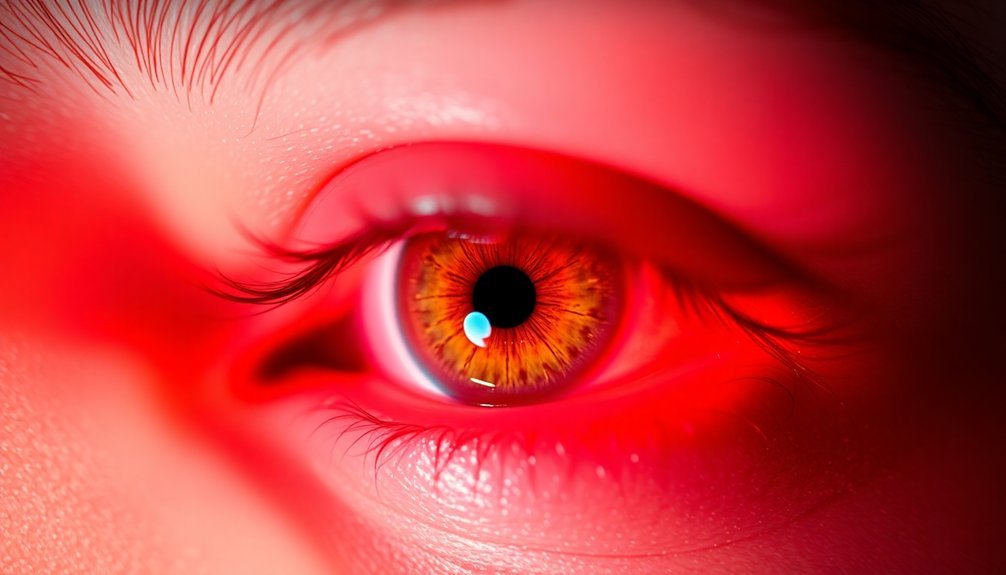
While your retina faces daily threats from harmful blue light wavelengths (445-450nm), you can take proactive steps to shield your eyes from cumulative damage that often leads to age-related macular degeneration.
You'll find that red light therapy offers a safer alternative, stimulating retinal cell mitochondria and improving vision without the risks associated with blue light exposure.
To protect your retinal health, you should limit exposure to blue light sources and, if using red light therapy, follow safety guidelines to avoid direct viewing of the devices for more than three minutes.
Understanding Blue Light Dangers
In today's digital age, your eyes face constant exposure to blue light from an array of modern devices, including smartphones, computers, and LED lighting. What makes blue light particularly concerning is its high-energy, short wavelength nature that penetrates deep into your retina, potentially causing long-term damage.
When blue light reaches the back of your eye, it can trigger phototoxicity, a process that damages retinal cells and releases harmful toxic molecules. This damage contributes to age-related macular degeneration (AMD) and may accelerate the formation of cataracts. Your risk increases with prolonged exposure, especially when you're viewing screens at close range for extended periods.
You'll also find that blue light disrupts your natural sleep patterns. When you're exposed to blue light in the evening, it suppresses your body's melatonin production, making it harder to get quality rest.
That's why it's essential to limit your screen time at least three hours before bedtime. To protect your eyes, you can take practical steps like using blue light filters on your devices, wearing computer glasses with yellow-tinted lenses, and taking regular breaks from screen time.
Red Light Safety Benefits
Contrary to blue light's harmful effects, red light therapy offers remarkable protection for your retinal health. When you undergo red light therapy, it stimulates your eye cells' mitochondria, boosting ATP production and enhancing cellular energy. This process actively shields your eyes from damage while reducing harmful reactive oxygen species that can impair your vision.
Clinical studies show that you'll experience a 17-20% improvement in visual acuity and color contrast vision with regular treatments. The therapy's protective effects can last up to a week, making it an effective weekly treatment option for maintaining eye health.
You'll find it particularly beneficial if you're dealing with conditions like age-related macular degeneration or glaucoma.
- Your retinal cells receive enhanced protection through increased mitochondrial membrane potential
- You'll experience reduced ocular inflammation, a key factor in preventing vision loss
- Your eyes benefit from improved healing and recovery after injuries
- You can maintain better long-term eye health with just weekly 3-minute sessions
Red light therapy's safety profile makes it an ideal choice for protecting your vision, especially when used correctly and consistently as part of your eye care routine.
Best Wavelengths For Vision
Three specific wavelengths stand out as particularly effective for protecting your retinal health: 670nm, 780nm, and 830nm. Among these, 670nm has been the most extensively studied, showing remarkable benefits for eye health and vision improvement.
In clinical studies, this wavelength has demonstrated its ability to reduce age-related retinal inflammation and enhance mitochondrial function.
You'll find the timing of your light therapy matters substantially. Morning sessions prove most effective because your mitochondria function at peak efficiency during these hours. A brief three-minute exposure to 670nm light once weekly can improve your color contrast vision by up to 17%.
If you're over 40, you'll likely notice enhanced color perception and better low-light vision.
Near-infrared wavelengths of 780nm and 830nm offer additional protection for your retina, particularly if you're dealing with conditions like retinitis pigmentosa or glaucoma. These wavelengths help protect your cornea and promote cellular growth.
The benefits aren't temporary – improvements can last for at least a week after treatment, making this therapy an efficient option for maintaining your eye health.
Age-Related Vision Support
Recent breakthroughs in red light therapy have opened promising avenues for addressing age-related vision decline. Studies show that just three minutes of deep red light exposure in the morning can improve your color vision by 17%, with benefits lasting up to a week.
This therapy works by recharging your retinal cells' energy system, specifically targeting the mitochondria when they're most receptive during morning hours.
You'll find this treatment particularly beneficial if you're experiencing age-related vision changes, as it directly addresses declining ATP production in your retinal cells. Clinical trials have demonstrated significant improvements in visual acuity and reduced symptoms of macular degeneration, including decreased edema and hemorrhaging.
- Your mitochondrial function peaks in the morning, making early exposure essential for maximum benefits
- You don't need daily treatments – weekly sessions can provide significant vision improvements
- Your color contrast perception and overall visual acuity can improve with consistent therapy
- You can administer this treatment at home with appropriate devices, making it accessible and convenient
The therapy's proven safety and effectiveness make it a promising option for maintaining your eye health as you age, potentially reducing the impact of age-related vision decline.
Light Therapy Safety Guidelines
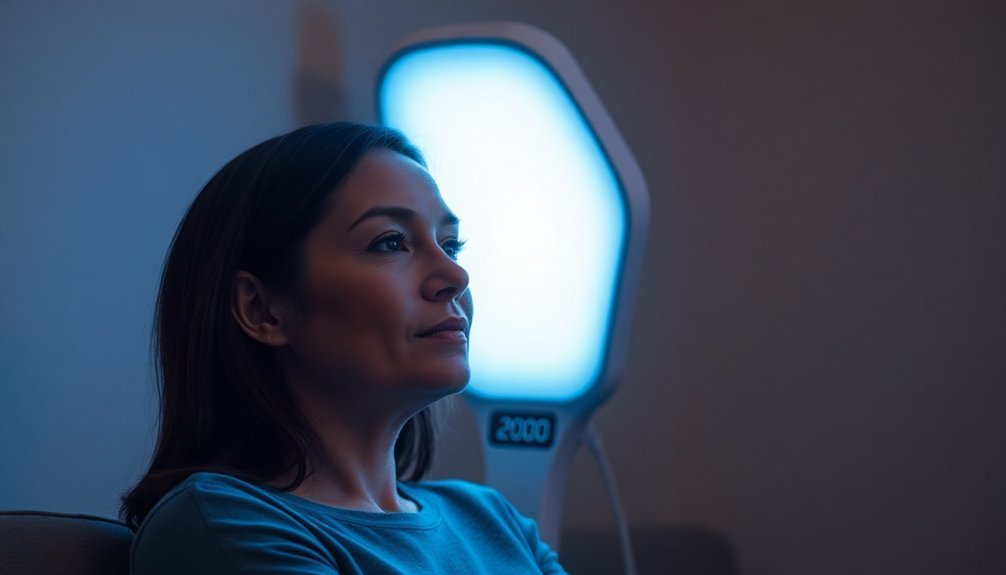
Protecting your eyes during light therapy requires careful attention to safety guidelines and proper equipment usage. You'll need to maintain proper distance from the light source, typically 6-12 inches, and always use appropriate eye protection designed for light therapy sessions.
Start with short 5-10 minute sessions and gradually increase duration as you become comfortable with the treatment. It's essential to invest in FDA-approved devices that operate within safe wavelength ranges of 620-700 nm.
| Safety Aspect | Do's | Don'ts |
|---|---|---|
| Eye Protection | Wear specialized goggles | Look directly at light source |
| Device Position | Keep 6-12 inches away | Place too close to face |
| Session Length | Start with 5-10 minutes | Exceed recommended time |
| Light Intensity | Use low-intensity settings | Skip safety checks |
| Professional Input | Consult healthcare provider | Self-diagnose conditions |
Before starting light therapy, consult your healthcare provider, especially if you have pre-existing eye conditions or increased photosensitivity. Monitor yourself for any discomfort or adverse effects during treatment. If you experience vision spots or eye strain, immediately stop the session and adjust your approach based on professional guidance.
Eye Treatment Wavelength Options
Selecting the right wavelength for eye light therapy comes down to understanding specific ranges and their therapeutic effects.
The most studied and effective wavelengths fall between 630-700nm, with 670nm showing particularly promising results for various eye conditions.
You'll find that combining red light with near-infrared wavelengths can enhance your treatment outcomes.
For the best results, you should consider devices that offer wavelength combinations rather than single-wavelength options. While 630nm and 660nm work well for surface eye health, deeper tissue healing often requires longer wavelengths like 810nm or 830nm.
It's worth noting that not all red light wavelengths are equally effective – research shows that 728nm and 980nm don't produce significant benefits.
- 670nm wavelength targets general eye health and has the most research backing
- 630-660nm wavelengths work best for surface eye conditions
- 810-850nm wavelengths penetrate deeper for internal eye healing
- Combined wavelength therapy (red + NIR) offers thorough treatment benefits
When choosing your light therapy device, verify it delivers appropriate power density (around 50mW/cm2) and keeps doses low (under 10J/cm2) for safe and effective treatment.
Morning Light Treatment Benefits
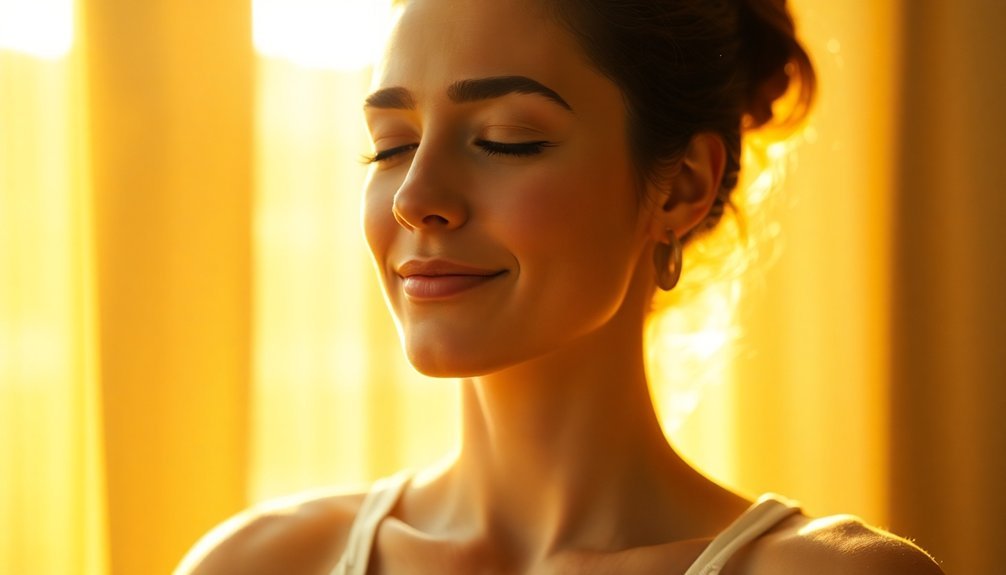
A groundbreaking discovery in light therapy shows that just three minutes of deep red light exposure in the morning can substantially boost your vision for up to a week. This simple treatment using 670-nanometer deep red light can improve your color contrast vision by up to 17%, with benefits lasting seven days or more.
The secret lies in your retina's mitochondria, which act like tiny batteries that power your eye cells. These cellular powerhouses follow your body's natural circadian rhythm and respond most effectively to light therapy in the morning.
When you expose your eyes to deep red light during these morning hours, you're fundamentally recharging these cellular batteries, enhancing their energy production and reducing harmful reactive oxygen species.
You'll get the best results by maintaining a weekly schedule of morning treatments. The therapy is safe, using a gentle 8mW/cm² energy level that won't damage your eyes.
Studies show consistent benefits across all genders, working effectively for people aged 34 to 70. However, if you try this treatment in the afternoon, you likely won't see any improvement – timing really is everything when it comes to boosting your vision with red light therapy.
Home Light Therapy Applications
While morning red light therapy can enhance vision, you'll find various light therapy devices available for home use that target different health concerns. These devices come in different forms, including masks, wands, panels, and beds, each designed for specific treatment areas.
When using these devices, you'll need to maintain a distance of 6-12 inches from your skin and follow recommended session times of 10-20 minutes.
For safe and effective treatment, you must always wear proper eye protection and use FDA-cleared devices according to manufacturer instructions. While home devices mightn't match the intensity of professional treatments, they offer convenience and can still provide significant benefits when used consistently 3-5 times per week.
- Choose devices with FDA clearance to guarantee safety standards are met
- Clean your skin thoroughly before each treatment session
- Apply additional sunscreen post-treatment and avoid direct sunlight
- Never skip eye protection, even if you're not treating facial areas
Remember to exercise caution if you have pre-existing eye conditions or increased photosensitivity. While light therapy is non-invasive and generally safe, it's crucial to follow proper guidelines and discontinue use if you experience any discomfort.
Frequently Asked Questions
Can Light Therapy Help With Night Vision Problems?
Light therapy won't directly improve your night vision problems. While it can boost your eye's cellular health through mitochondrial stimulation, it's mainly beneficial for age-related vision issues rather than night blindness specifically.
How Soon After Eye Surgery Can Someone Start Light Therapy?
You'll typically need to wait about one week after cataract surgery before starting light therapy. You can also have sessions before surgery to prepare your eyes and improve post-operative outcomes.
Does Wearing Contact Lenses Affect Light Therapy Effectiveness?
You'll need to remove your contact lenses before light therapy sessions for maximum effectiveness. While lenses don't completely block treatment, they can reduce the therapeutic benefits and interfere with light penetration to your eyes.
Can Light Therapy Treat Seasonal Eye Allergies?
You shouldn't use light therapy to treat seasonal eye allergies as there's no scientific evidence supporting this use. Instead, consult your healthcare provider for appropriate treatments like antihistamines or eye drops.
Is Light Therapy Safe During Pregnancy for Eye Conditions?
You'll be glad to know light therapy is generally safe during pregnancy for eye conditions. It's similar to natural daylight exposure, but you should still consult your ophthalmologist before starting any light therapy treatment.
In Summary
You'll find light therapy offers several benefits for your eye health when used correctly. It is crucial to choose the right wavelengths and follow proper safety protocols. Whether you're looking to support aging eyes, protect retinal cells, or improve your circadian rhythm, light therapy can be an effective tool. Remember to consult an eye care professional before starting any light therapy regimen to verify it is appropriate for your needs.
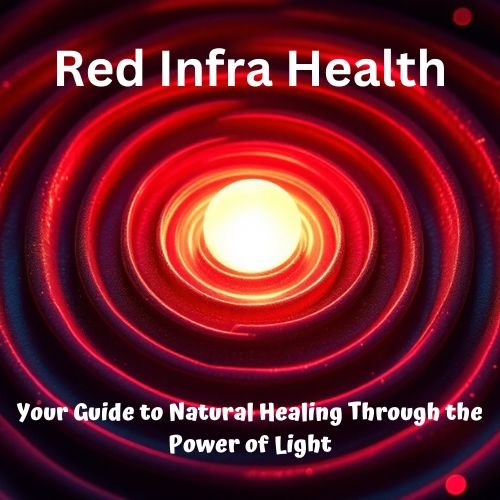


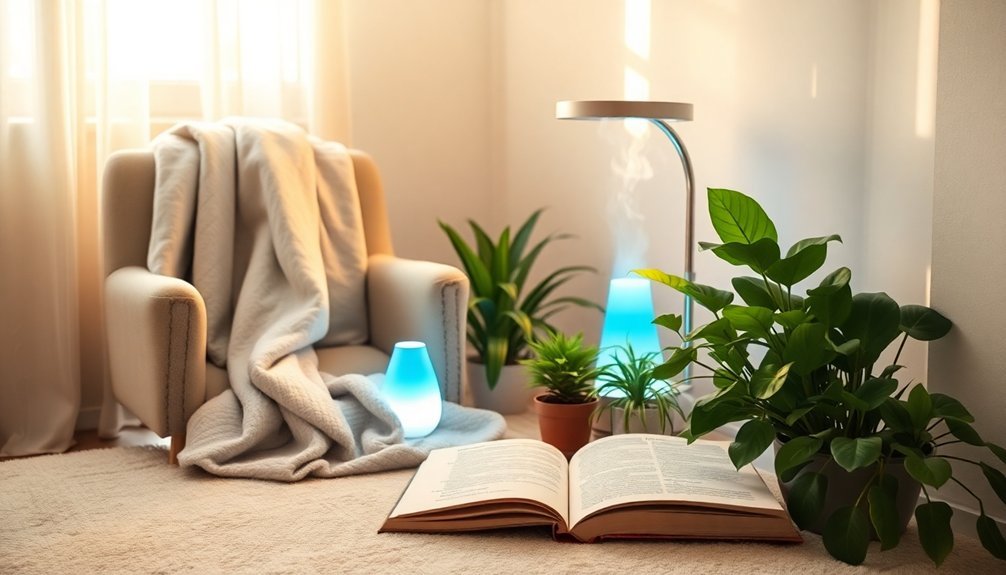

Leave a Reply